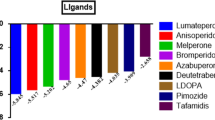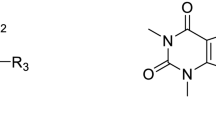Abstract
Parkinson’s disease is a neurological illness that slowly impairs a small number of neurons in the substantia nigra, a part of the brain. Dopamine, a substance (neurotransmitter) that disseminates signals to different regions of the brain and, when it functions correctly, coordinates smooth and balanced muscular activity, is typically produced by these cells. One-hand tremor is frequently the first sign of Parkinson’s disease. Loss of balance, stiffness, and delayed mobility are further symptoms. Proteins including catechol-O-methyltransferase and dopamine D3 receptors were taken into consideration as prospective therapeutic targets in this study. Two ligand-based pharmacophore models were generated with the help of compounds used for Parkinson’s disease which have structural similarity, screened from the first 16 compounds found in the drug bank. In the second case, 9 compounds that have similar structure to the compound istradefylline were selected. Based on docking score, intermolecular interactions, ADME (absorption, distribution, metabolism, and excretion) features, pharmacophore, and toxicity investigations, the inhibitors among the chosen compounds were found. Additionally, the chosen inhibitor underwent a 100 nanosecond molecular dynamics simulation with the two protein targets to determine its stability and binding affinity. The compound 3,4-Bis(1,3,5,6-heptatetraenyloxy) benzaldehyde was identified to be the most promising lead molecule in this analysis due to its better binding affinity, better pharmacophore properties, and greater stability. Hence, by targeting both specified proteins, the compound 3,4-Bis(1,3,5,6-heptatetraenyloxy) benzaldehyde should be beneficial against Parkinson’s disease.












Similar content being viewed by others
Availability of data and materials
Not applicable.
References
Ball N, Teo W-P, Chandra S, Chapman J (2019) Parkinson’s disease and the environment. Front Neurol 10:218
Dauer W, Przedborski S (2003) Parkinson’s disease: mechanisms and models. Neuron 39(6):889–909
de Lau LML, Breteler MMB (2006) Epidemiology of Parkinson’s disease. Lancet Neurol 5(6):525–535
Mysinger MM, Carchia M, Irwin JJ, Shoichet BK (2012) Directory of useful decoys, enhanced (DUD-E): better ligands and decoys for better benchmarking. J Med Chem 55(14):6582–6594
Poewe W, Seppi K, Tanner CM, Halliday GM, Brundin P, Volkmann J, Schrag A-E, Lang AE (2017) Parkinson disease. Nat Rev Dis Primers 3:17013
Cruz-Vicente P, Gonçalves AM, Ferreira O, Queiroz JA, Silvestre S, Passarinha LA, Gallardo E (2021) Discovery of small molecules as membrane-bound catechol-o-methyltransferase inhibitors with interest in parkinson’s disease: Pharmacophore modeling, molecular docking and in vitro experimental validation studies. Pharmaceuticals (Basel) 15(1):51
Patel CN, Georrge JJ, Modi KM, Narechania MB, Patel DP, Gonzalez FJ, Pandya HA (2017) Pharmacophore-based virtual screening of catechol-o-methyltransferase (COMT) inhibitors to combat Alzheimer’s disease. J Biomol Struct Dyn 36(15):3938–3957
Joyce JN (2001) Dopamine D3 receptor as a therapeutic target for antipsychotic and antiparkinsonian drugs. Pharmacol Ther 90(2–3):231–259
Wang S, Wacker D, Levit A, Che T, Betz RM, McCorvy JD, Venkatakrishnan AJ, Huang X-P, Dror RO, Shoichet BK, Roth BL (2017) D(4) dopamine receptor high-resolution structures enable the discovery of selective agonists. Science 358(6361):381–386
Sun B, Feng D, Chu ML-H, Fish I, Lovera S, Sands ZA, Kelm S, Valade A, Wood M, Ceska T, Kobilka TS, Lebon F, Kobilka BK (2021) Crystal structure of dopamine D1 receptor in complex with G protein and a non-catechol agonist. Nat Commun 12(1):3305
Khan ZU, Gutiérrez A, Martín R, Peñafiel A, Rivera A, de la Calle A (2000) Dopamine D5 receptors of rat and human brain. Neuroscience 100(4):689–699
Milligan G, Kostenis E (2006) Heterotrimeric g-proteins: a short history. Br J Pharmacol 147(S1):46–55
Wang S, Che T, Levit A, Shoichet BK, Wacker D, Roth BL (2018) Structure of the D2 dopamine receptor bound to the atypical antipsychotic drug risperidone. Nature 555(7695):269–273
Ahmed SSSJ, Ahameethunisa A, Santosh W (2010) QSAR and pharmacophore modeling of 4-arylthieno [3, 2-d] pyrimidine derivatives against adenosine receptor of Parkinson’s disease. J Theor Comput Chem 09(06):975–991
Yang S-Y (2010) Pharmacophore modeling and applications in drug discovery: challenges and recent advances. Drug Discov Today 15(11–12):444–450
Schaller D, Šribar D, Noonan T, Deng L, Nguyen TN, Pach S, Machalz D, Bermudez M, Wolber G (2020) Next generation 3D pharmacophore modeling. WIREs Comput Mole Sci 10(4):1468
Kaserer T, Beck KR, Akram M, Odermatt A, Schuster D (2015) Pharmacophore models and pharmacophore-based virtual screening: concepts and applications exemplified on hydroxysteroid dehydrogenases. Molecules 20(12):22799–22832
Cummins L, Cates ME (2022) Istradefylline: a novel agent in the treatment of “off’’ episodes associated with levodopa/carbidopa use in parkinson disease. Ment Health Clin 12(1):32–36
Reva BA, Finkelstein AV, Skolnick J (1998) What is the probability of a chance prediction of a protein structure with an RMSD of 6 å? Fold Des 3(2):141–147
Daina A, Michielin O, Zoete V (2017) SwissADME: a free web tool to evaluate pharmacokinetics, drug-likeness and medicinal chemistry friendliness of small molecules. Sci Rep 7:42717
Benet LZ, Hosey CM, Ursu O, Oprea TI (2016) BDDCS, the rule of 5 and drugability. Adv Drug Deliv Rev 101:89–98
Persidsky Y, Ramirez SH, Haorah J, Kanmogne GD (2006) Blood-brain barrier: structural components and function under physiologic and pathologic conditions. J Neuroimmune Pharmacol 1(3):223–236
Krewski D, Acosta D Jr, Andersen M, Anderson H, Bailar JC 3rd, Boekelheide K, Brent R, Charnley G, Cheung VG, Green S Jr, Kelsey KT, Kerkvliet NI, Li AA, McCray L, Meyer O, Patterson RD, Pennie W, Scala RA, Solomon GM, Stephens M, Yager J, Zeise L (2010) Toxicity testing in the 21st century: a vision and a strategy. J Toxicol Environ Health B Crit Rev 13(2–4):51–138
Meng X-Y, Zhang H-X, Mezei M, Cui M (2011) Molecular docking: a powerful approach for structure-based drug discovery. Curr Comput Aided Drug Des 7(2):146–157
Samdani A, Vetrivel U (2018) POAP: a GNU parallel based multithreaded pipeline of open babel and AutoDock suite for boosted high throughput virtual screening. Comput Biol Chem 74:39–48
Adcock SA, McCammon JA (2006) Molecular dynamics: survey of methods for simulating the activity of proteins. Chem Rev 106(5):1589–1615
Fatemi SM, Fatemi SJ, Abbasi Z (2020) Pamam dendrimer-based macromolecules and their potential applications: recent advances in theoretical studies. Polym Bull 77(12):6671–6691. https://doi.org/10.1007/s00289-019-03076-4
Al-Raeei M, El-Daher MS (2021) Temperature dependence of the specific volume of Lennard-Jones potential and applying in case of polymers and other materials. Polym Bull 78(3):1453–1463. https://doi.org/10.1007/s00289-020-03166-8
Alperstein D, Knani D, Goichman A, Narkis M (2012) Determination of plasticizers efficiency for nylon by molecular modeling. Polym Bull 68(7):1977–1988. https://doi.org/10.1007/s00289-012-0705-2
Sahihi M, Gaci F, Navizet I (2021) Identification of new alpha-synuclein fibrillogenesis inhibitor using in silico structure-based virtual screening. J Mol Graph Model 108(108010):108010
Kufareva I, Abagyan R (2012) Methods of protein structure comparison. Methods Mol Biol 857:231–257
Services CB (2013) CD ComputaBio. Accessed on May 16th, 2023. https://www.computabio.com/rmsd-rmsf-analysis-service.html
Sargsyan K, Grauffel C, Lim C (2017) How molecular size impacts RMSD applications in molecular dynamics simulations. J Chem Theory Comput 13(4):1518–1524
Reva BA, Finkelstein AV, Skolnick J (1998) What is the probability of a chance prediction of a protein structure with an RMSD of 6 a? Fold Des 3(2):141–147
Martínez L (2015) Automatic identification of mobile and rigid substructures in molecular dynamics simulations and fractional structural fluctuation analysis. PLoS ONE 10(3):0119264
Fuglebakk E, Echave J, Reuter N (2012) Measuring and comparing structural fluctuation patterns in large protein datasets. Bioinformatics 28(19):2431–2440
Jolla L (2018) BioChemCoRe 2018. Accessed on June 3rd, 2023. https://ctlee.github.io/BioChemCoRe-2018/rmsd
Gowers R, Linke M, Barnoud J, Reddy T, Melo M, Seyler SL, Dotson D, Domanski J, Buchoux S, Kenney I (2016) Mdanalysis: a python package for the rapid analysis of molecular dynamics simulations
Durdagi S, Duff HJ, Noskov SY (2011) Combined receptor and ligand-based approach to the universal pharmacophore model development for studies of drug blockade to the hERG1 pore domain. J Chem Inf Model 51(2):463–474
Sen D, Chatterjee T (2013) Pharmacophore modeling and 3d quantitative structure-activity relationship analysis of febrifugine analogues as potent antimalarial agent. J Adv Pharm Technol Res 4:50–60. https://doi.org/10.4103/2231-4040.107501
Thangapandian S, John S, Lee Y, Kim S, Lee KW (2011) Dynamic structure-based pharmacophore model development: a new and effective addition in the histone deacetylase 8 (HDAC8) inhibitor discovery. Int J Mol Sci 12(12):9440–9462
Butina D, Segall MD, Frankcombe K (2002) Predicting ADME properties in silico: methods and models. Drug Discov Today 7(11):83–8
Toropov AA, Toropova AP, Raska I Jr, Leszczynska D, Leszczynski J (2014) Comprehension of drug toxicity: software and databases. Comput Biol Med 45:20–25
Crisan L, Istrate D, Bora A, Pacureanu L (2021) Virtual screening and drug repurposing experiments to identify potential novel selective MAO-B inhibitors for parkinson’s disease treatment. Mol Divers 25(3):1775–1794
Li P, Zhao L (2007) Developing early formulations: practice and perspective. Int J Pharm 341(1–2):1–19
Pandey A (2003) North East BioLab. Accessed on May 22nd, 2023. https://www.nebiolab.com/drug-discovery-and-development-process/
Bonifácio MJ, Archer M, Rodrigues ML, Matias PM, Learmonth DA, Carrondo MA, Soares-Da-Silva P (2002) Kinetics and crystal structure of catechol-o-methyltransferase complex with co-substrate and a novel inhibitor with potential therapeutic application. Mol Pharmacol 62(4):795–805
Funding
The authors did not receive support from any organization for the submitted work.
Author information
Authors and Affiliations
Contributions
All authors contributed to the study conception and design. Material preparation, and data collection and analysis were performed by AJ, SM, NMT, MC, ADM, and AJ. The first draft of the manuscript was written by NMT and SM, and all authors commented on previous versions of the manuscript. All authors read and approved the final manuscript.
Corresponding author
Ethics declarations
Conflict of interest
All authors certify that they have no affiliations with or involvement in any organization or entity with any financial interest or non-financial interest in the subject matter or materials discussed in this manuscript.
Ethics approval
Not applicable.
Consent to participate
Not applicable.
Consent for publication
All the authors informed the consent for publication.
Code availability
Not applicable.
Additional information
Publisher's Note
Springer Nature remains neutral with regard to jurisdictional claims in published maps and institutional affiliations.
Rights and permissions
Springer Nature or its licensor (e.g. a society or other partner) holds exclusive rights to this article under a publishing agreement with the author(s) or other rightsholder(s); author self-archiving of the accepted manuscript version of this article is solely governed by the terms of such publishing agreement and applicable law.
About this article
Cite this article
Joy, A., Menon, S., Thomas, N.M. et al. Pharmacophore modelling and molecular dynamics simulation to identify novel molecules targeting catechol-O-methyltransferase and dopamine D3 receptor to combat Parkinson’s disease. Polym. Bull. (2023). https://doi.org/10.1007/s00289-023-05087-8
Received:
Revised:
Accepted:
Published:
DOI: https://doi.org/10.1007/s00289-023-05087-8




